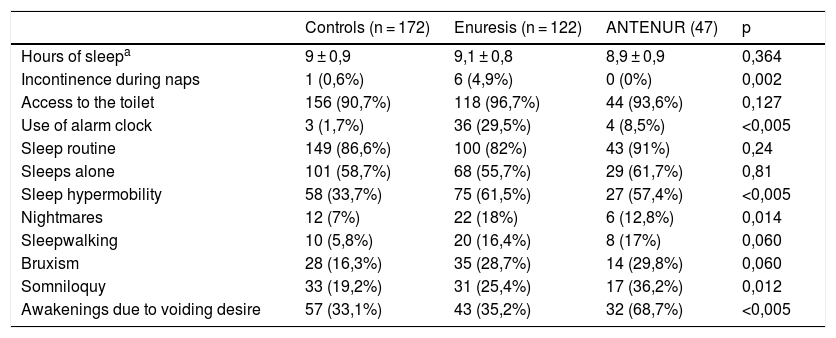To analyze if there is a higher prevalence of sleep disturbances and hygiene disorders in patients with monosymptomatic enuresis (MEN) with respect to general population and to patients with corrected MEN. Assess the usefulness of the BEARS sleep disorder screening tool for children with MEN.
Material and methodsTransverse observational study (n = 341) classified as: MEN (n = 122), corrected MEN (≥1 one year without recurrence) (ANTENUR) (n = 47) and controls (n = 172). The BEARS childhood sleep disorder screening questionnaire was used. Clinical variables were collected, as well as variables related to sleep hygiene. Statistics: Chi-square, Student's t, ANOVA, Mann-Whitney U and Kruskal-Wallis. Significance p < 0.05.
ResultsMean age 9.7 ± 3.0 years. There were no statistically significant differences in terms of age, sex, BMI, history of tonsillectomy, asthma and sleep time hours. With respect to sleep hygiene, patients with MEN presented a higher percentage of alterations than controls. As for the BEARS questionnaire, it showed a higher prevalence of sleep disorders in the group of patients with MEN, with respect to the other two groups: 60.7% (n = 74) versus 18.6% (n = 32) and 38.3% (n = 18) of controls and ANTENUR, respectively (p < 0.05).
ConclusionsChildren with MEN had a higher prevalence of sleep disturbances and sleep disorders than controls. The BEARS questionnaire is a useful clinical tool in the detection of sleep disorders in children.
Analizar si existe mayor prevalencia de trastornos del sueño y desórdenes en su higiene en los pacientes con enuresis monosintomática (ENM) con respecto a la población general y a los pacientes con ENM corregida. Valorar la utilidad de la escala de cribado de trastornos del sueño en la infancia BEARS en la ENM.
Material y métodosEstudio observacional transversal (n = 341) clasificados en: ENM (n = 122), ENM corregida (≥1 a un año sin recidiva) (ANTENUR) (n = 47) y controles (n = 172). Se utilizó el cuestionario de cribado de trastornos del sueño en la infancia BEARS. Se recopilaron variables clínicas, así como variables en referencia a la higiene del sueño. Estadísticos: chi cuadrado, t de Student, ANOVA, U Mann-Whitney y Kruskall-Wallis. Significación p < 0,05.
ResultadosMedia de edad 9,7 ± 3,0 años. No existieron diferencias estadísticamente significativas con respecto a edad, género, IMC, antecedente de amigdalectomía, asma y número de horas de sueño. Con respecto a la higiene del sueño, los pacientes con ENM presentaron mayor porcentaje de alteraciones con respecto a los controles. En cuanto al cuestionario BEARS, demostró mayor prevalencia de alteraciones del sueño en el grupo de pacientes con ENM, con respecto a los otros dos grupos. Un 60,7% (n = 74) frente al 18,6% (n = 32) y el 38,3% (n = 18) de los controles y ANTENUR, respectivamente (p < 0,05).
ConclusionesLos niños con ENM presentaron mayor prevalencia de desórdenes durante el sueño así como en la higiene de este, con respecto a los controles. El cuestionario BEARS es una herramienta clínica útil en la detección de los desórdenes del sueño en el niño.












